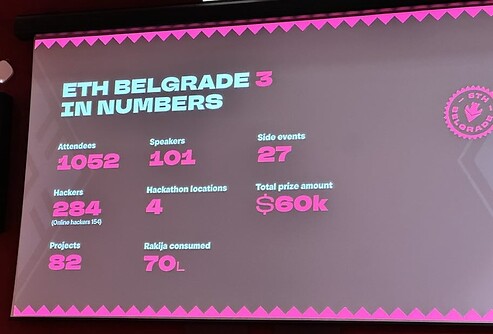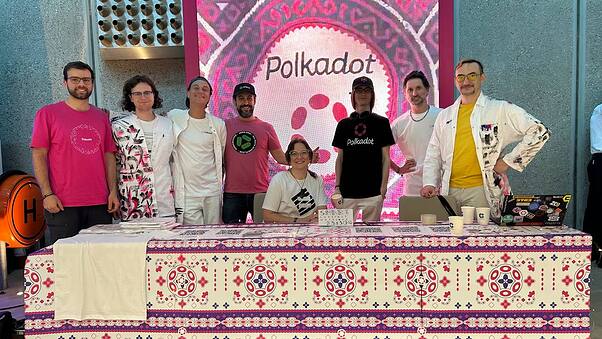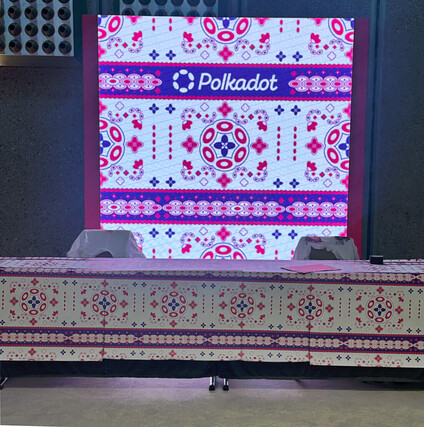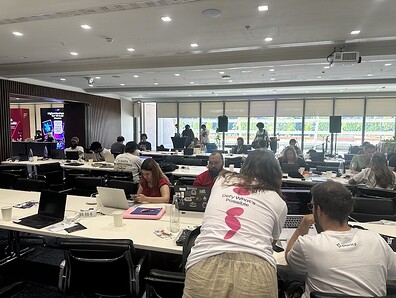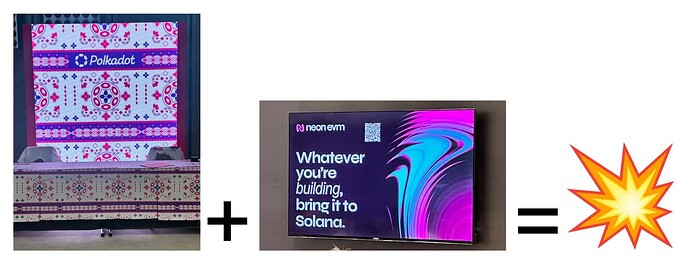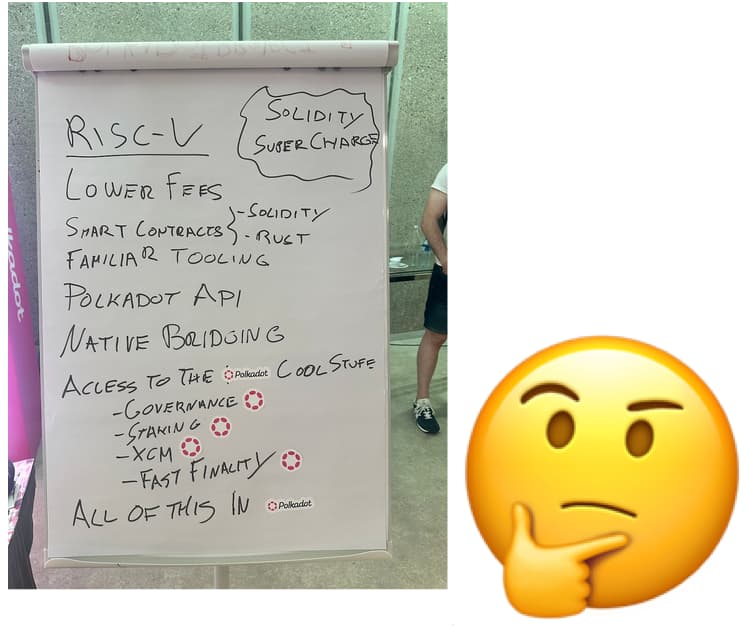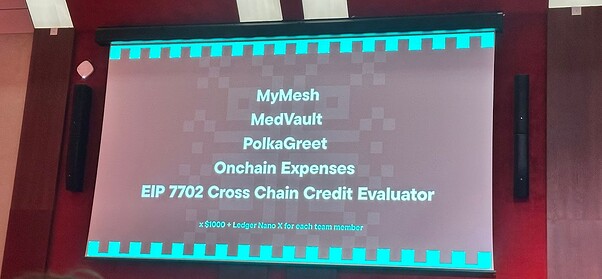In the first week of June, DevCult flew to the capital of Serbia to throw a Smart Contracts based hackathon in ETH Belgrade, the biggest crypto event in the Balkans.
Note: This is a new forum account, so we are limited to post images and links. For the report in its original format please visit: [Published] ETHBelgrade 2025 - Forum post - Polkadot goes Balkan - Google Docs
WTF is DevCult ?
“In 2024, a crack engineering team were decentralised for a crime they didn’t commit. These men promptly escaped from a maximum security stockade to the Polkadot Ecosystem underground. Today, they survive as soldiers of fortune. If you have a DexEx problem, if no one else can help with your Developer Relations and if you can find them, maybe you can hire DevCult.”
DevCult is a recently created DevRel team, formed by 3 former Parity people ( Denis P , Sacha L and Daniel A) and Boris G. We know the tech, we know the faces in front and behind the tech, we know the context, and most importantly, we are aware of some of the Polkadot issues, and we take the mission from a different angle: user centric approach.
Open source advocates, Systems Engineering practitioners, and extremely practical, DevCult is here to help to address and close the multiple gaps between users, usage and technical adoption - but not cutting corners. We believe Polkadot should be accessible and onboardable for beginner and intermediate users only using online search engines and online resources. Universal access is key for adoption, going away from the current model relying on private contact networks, cryptic and obscure documentation, and complex, incomplete and confusing user journeys.
Privileges of knowing are ancien régime, format and standardization is modernity. The paradigm in which information remains locked inside a few individuals’ minds, rather than being accessible to all, is being dismantled. Similarly outdated is the mindset that complexity is inherently exciting. By establishing clear standards and formats, we disrupt these dynamics, enabling broader access, growth, and meaningful use.
Accessibility (documentation, knowledge bases, user experience and abstraction of complex topics) is fundamental to growing Polkadot town into a vibrant Polkadot city.
TL:DR - ETHBelgrade 2025
ETH Belgrade conference and hackathon happened between the 3rd and 5th of June in Sava Centar in Belgrade. It gathered around 1000 attendees the 3 days of the event and 284 hackers (a relevant number of them online).
ETHBelgrade was a continuation of the DevCult strategy - started in ETHLisbon, by the hand of Pala Labs - of throwing hackathons in small to medium size ETH events, which address local developer communities, and also ETH event adventurers and/or bounty hunters. The costs of sponsorship and expenses are significantly lower and the attendees are more focused on the main event instead of being distracted/overwhelmed with gazillions of side-events. At the point of the development of smart contract tech we consider it the right approach: small, agile, cost mindful, impactful.
The booth interaction allowed the team to gather critical information about Polkadot perception and brand recognition ( SPOILER ALERT: in the EVM world, Polkadot is almost an unknown player ) and to iterate and polish messaging about the new features coming to Polkadot, in the shape of smart contracts. Mentioned RISC-V VM close to production caught the attention of many guests, and many were surprised that it was relevant on the ongoing hackathon with (alpha) Solidity Smart Contracts. Right messaging and active engagement with a clear value proposition is key to convert and attract people to Polkadot.
On the hackathon front, the team delivered extremely well, being the sponsor that had more submissions (21 of total 82) in top of other contenders with even more prize pool. Moreover, two of the Polkadot awarded projects were also awarded in the main track. Valuable technical insights were collected both from the DevRel team and the Parity engineers.
On the learnings and details to improve, the team was definitely a bit short in design and merch budget - points that will be improved in next events. On the communication side, it is important to combine nice and attractive design with precise messaging about the product Polkadot delivers. Same idea for the booth engagement, messaging needs to be fine tuned to deliver a precise, consistent and attractive message.
In overall, the event was a success from where the team and Polkadot got insightful learnings about tech testing, product messaging, brand positioning and exposure to Solidity environment.
ETHBelgrade in numbers
Attendees: 1052
Hackers: 284 ( online 154 )
Hackathon submissions: 21 of 82 ( 25.6% )
Projects Awarded: 11 ( 2 Honorary mentions )
Post hackathon leads generated: 13 ( Lead by parity )
Merch handled: 100% T-Shirts, 50% Stickers
Projects awarded in the main track: 2 of 5
Prize awarded of Polkadot prize pool: 78.84% / 5193 USD
Days from conclusion to last bounty payout: 16 working days
Contracts deployed in Passet Hub: 421 contracts
New users in discord (3-5 June): 82
New users in Telegram (3-5 June): 51
Rakija consumed by the team: 0 Liters
Final Cost: 35134 USD*
Hackathon projects accessible here.
Note: On budget, we applied a war economy mindset, sometimes cutting too much in some aspects ( reach, design, merch ) and with team fees lower than the usual specialist engineer rate on the ecosystem. We will adjust in our next gigs.
The Hackathon Team
DevCult had the in situ direct support from Parity with 3 engineers ( Tiago, Rebecca and Maciej), and Nick K on remote as Parity Technical Support.
The DevCult team ran the hackathon, with the technical support of Tiago and Maciej, who engaged with hacking participants. And not only direct one-to-one close combat technical support, they provided context: the Smart Contract hackathon workshop talk of Tiago to kick start the hack and Maciej’s booth time engaging and providing excellent technical explanations of Polkadot. NK assisted remotely.
Rebecca and Daniel supervised and managed the booth, merch and engagement, as well as judging the Polkadot tracks.
We would like to thank Parity for the support - also the people to spun out Passet Hub just for the hackathon.
The booth
The booth resulted in a nice surprise in terms of utility. The localised slavic/serbian Polkadot themed pattern and the old school Polkadot carpet gave us a fresher and not-so-corporate look, while directly providing an original way to refer to local cultural identities, on which guests could feel related or identified, both with the seriousness of the pattern or the irony of the carpet. The guest loved the booth design and they mentioned it to us directly. As a result, the booth was one of the more popular (if not the most).
On the booth, we handled merch in exchange of Discord and/or Telegram platform joining, locking in around 10% of the attendees of the conference. On the booth conversations, the team gathered important information about Polkadot perception and brand recognition, as well as what aspects of Polkadot’s coming smart contracts platform people were interested in:
-
In the EVM world Polkadot is almost an unknown player
-
For the people who knew about Polkadot:
- They think that it is dead
AND/OR
-
Most people who knew about Polkadot, are still thinking in the parachain paradigm (parachain term usage here is intended)
-
Many guests were shocked (and impressed) to learn about the close to production RISC-V platform, and it being actually relevant to the Ethereum hackathon. Probably Vitalik’s EVM → RISC-V early 2025 public discussion made RISC-V a more attractive and known technology in the Ethereum world.
-
XCM and the potential for multiple language support (with RISC-V) especially generated excitement with the attendees we spoke to.
-
Many people who were not familiar with Polkadot were also very interested in the inherent sharded architecture, considering the current Ethereum L2 boom and fragmentation
-
Some disgruntled guests complained about the poor price action performance of DOT (well, what can we do here? ¯_(ツ)_/¯ )
This interaction allowed the team to gather critical information about Polkadot perception and brand recognition, and to iterate and polish messaging about the new features coming to Polkadot, in the shape of smart contracts.
The shy 100 T-shirts were almost gone by the second day, while stickers were not so popular. The generic designs we used were not attractive. A more brave and original design, like the ones used in the booth and funny or tech related jokes ( “Teach your solidity code new Polkadot tricks”, ”Don’t wait, RISC-V Now”, … ) could result in a better engagement.
Care, right messaging and active engagement with a clear value proposition is a key to convert and attract people to Polkadot. Including being ambitious, precise and direct in messaging, which can include topics of specific interest for specific audiences.
As mentioned later in the fuck-ups section, not everything was perfect and the team gathered some learning on messaging, merch and communication. There is always room for improvement.
The hackathon
Launching a smart contract hackathon was the principal objective of the event. We were competing with 10 other brands for the hacker’s attention and skills. On hackathons teams try to maximize their rewards by integrating multiple products from different sponsors, but the Polkadot was quite successful attracting hackers online and offline even against projects with a similar or bigger prize pool.
For winners, 11 NFTs were minted using dotmemo.xyz( and of course, we have some feedback about the product, some of the features coming on the next version ![]() ), PBA-X vouchers distributed, and bounty rewards in USDC. In this aspect, we had to request a Polkadot address, 4 of the 11 projects submitted an Ethereum address ( -_-! ). Some of the users also provided a Trust wallet address, so they could not manage the USDC funds after the test TX, so we needed to convince them to spin out another address using another wallet.
), PBA-X vouchers distributed, and bounty rewards in USDC. In this aspect, we had to request a Polkadot address, 4 of the 11 projects submitted an Ethereum address ( -_-! ). Some of the users also provided a Trust wallet address, so they could not manage the USDC funds after the test TX, so we needed to convince them to spin out another address using another wallet.
What went well?
The team was well coordinated and everyone knew what to do. The booth had good attendance and drew the attention of many visitors, and many visitors manifested that it was the best looking, with a fresh and original design. Interactions at the booth gave the opportunity to gather relevant information and the merch flew on the first day and half of the event.
On the hackathon front, the team outperformed any other sponsor on the ground, providing direct support and receiving feedback. Polkadot resulted in the sponsorship with more submissions (21 out of 82 projects) and two of the hackathon Main track winners - out of 5 - were Polkadot projects.
This was the credit of the hard work of the team doing DevRel and support on the event. On many levels live presence helps hackers to choose the tech. Hackers on the Polkadot tracks knew where to seek for help - on- and offline - and didn’t hesitate to approach DevRel or core devs directly. To aid with the offline recognition, DevCult’s signature Lab coats painted by hand by @XyloDrone were absolutely helpful.
Core devs and PM were very excited about their experience in a set of new roles: engaging and tech-supporting the real power-users, helping to provide new views on the product they are working on, filing new project issues from this new perspective, and closing this really short feedback loop for the alpha product. Judging the submissions also gave key insights and Polkadot perception to the team.
One of the hackathon participants was selected for PBA Bali, and also started an interview process at Parity.
But not everything is “La vie en Rose” ?
As most of the audience was technical, we realised we need a concise messaging to address the guest with precision about the strong points of the incoming tech landing in Polkadot. And more important, synthesize and add these messaging to the booth design and text.
There is a crucial need to be precise and concrete on the booth and merch messaging, to make clear to the visitors “what this Polkadot thing is about”. To be honest with ourselves and putting Polkadot in front of the mirror, the majority of the audience on the event didn’t know anything - or almost anything - about Polkadot, they didn’t know about any new features that are coming, and a few visitors that knew about Polkadot still associated it only with the parachain model.
From the booth staff, instead of talking about Polkadot in the beginning, the question “What do you know about Polkadot” was directed to the guests, to measure the temperature of brand recognition and general knowledge about Polkadot. In this case, the water is still very cold on the Ethereum community river.
During these conversations, one of the key topics that literally changed the guests’ facial expressions was the mention of RISC-V. The guests’ attention and energy levels increased and they genuinely wanted to learn more. This is something to consider when targeting developers.
Regarding the topic of messaging, we didn’t develop any merchandise in order to lower costs, and instead used existing stickers and T-shirt designs. Using precise messaging about the technology we are delivering, could make it more memorable, particularly for tech people who love tech jokes and details.
Image: The team recycled the Devrel whiteboards to transform them into Polkadot billboards. Maybe too casual, but effective.
In terms of engaging and attracting developers, we would like to add and push a more aggressive communication plan for funding paths for newcomers to every dev who comes to the booth: “these are the available funds, what they fund and how to apply”.
Team Formation and Project Clinic phases are from our perspective crucial things that drastically increase the quantity and quality of the submissions. It requires the hackathon organisers to arrange the technical workshops and team formation at the beginning of the hackathon timely. Otherwise, it’s not really possible to herd everyone and do the team-formation. We will keep iterating on them.
Finally, in terms of organisation, the process of making bounty payments is still a tedious, low-value and time consuming process. Dealing with participants, addresses, test TXs, security checks and impersonators is costly and could ( and should ) be automated to a great extent. Out of 11 winners, 25% submitted an Ethereum network address when asked for an address to pay the prizes, and another 20% submitted wallets not supporting AH ( Trust Wallet ).
Reports from the technology trench
The technology was still in the alpha stage and not completely functioning as the deployment target. Tutorial documentation is still at an early stage with basic “hello world” examples, and this hackathon ran before the Factory Contracts, precompiles and XCM were ready for integration. However, we approached the hackathon with the primary target of a product testing approach instead of a full showcase of the technology, resulting in huge benefits to be gained from early user testing.
We experienced some issues with the public testnet: Working with it was challenging due to faucet issues and rate limiting. This is particularly problematic when breaking changes are deployed on public testnets, causing network failures and jeopardising the hackathon. The focus could also be on local setup scaffolding with more complex scenarios, such as XCM-connected local nodes. Deployment and external developer engagement, like hackathons, can be coordinated more effectively, as these changes affect the developer experience, resulting in a negative experience for coders ( the ones we want to attract ).
Scaffolding and other tools and explorers were also in an early stage and didn’t always function as expected.
It is important to consider these issues with pre-alpha tech from three perspectives:
-
The DevRel team was aware of the state of the technology - still wet for newcomers to be fully onboarded. They approached it responsibly, however, dealing with the technology was challenging even for them.
-
The core team was prepared to answer all the raised issues, but not necessarily solve them. They collected a lot of crispy feedback though.
-
The hackers were sympathetic and felt involved. They were informed that the tech was still in alpha and were engaged to help. Although, they wouldn’t bring this tech back home just yet.
What we learned
During these days, the team gained the following insights:
-
Our hackathon model is maturing and producing better results.
-
Guests at the event had little or no knowledge of Polkadot
-
Booth and merch messaging should be original and refreshing, yet precise and on point. The budget we requested for this part was too low.
-
The booth is a two directional communication device: you share info but you also collect meaningful information. Actively engaging guests is crucial.
-
We should promote early funding pathways more aggressively at the booth and to hackathon participants.
-
We brought more feedback to the Parity smart contracts team
-
For the future hackathons, we will try to convince the hackathon hosts run a Team Formation session and inform hackers about Project Clinic feature
-
When executing the method using the Hardhat tools, the early benchmarks currently underperform compared to those on fully EVM-compatible blockchains, including Ethereum Sepolia. This needs further investigation.
-
We iterated over the Known Issues and managed to troubleshoot some of them in more detail
-
We collected some interesting feedback for Events Bounty (to help optimising their general and hackathon-related processes) and for the upcoming Bounty Pallet update
-
On an administrative level, we need to add diems to mentors and judges (-_-!)
-
We also need a bounty payout / claim tool.
Last Insights
Wrapping up, after the experience of ETHBelgrade, there are some extra insights and takeaways.
In general, we realised that Polkadot was way better prepared than other projects in the event, even better than bigger sponsors with bigger and more expensive booths. This allowed us to outperform other teams in the booth area and in the hackathon arena. This should be taken in consideration when addressing medium to small size events.
Polkadot should expand its event presence beyond ETH-focused gatherings, especially as the Ethereum ecosystem navigates its own challenges. This event presence, particularly designed for builders, should also include Web2 events. In this sphere it’s crucial to deliver clear, compelling messaging around why developers should build in Web3, underscoring its unique values and philosophy. Attractive web3 messaging combined with introductory technical workshops can be effective in sparking curiosity and drawing attention to Polkadot’s technology.
In our process of standardization and delivering great value to the Polkadot ecosystem, we have delivered a base metric list that will help teams and agents to evaluate the return of investment of these events. We would like to collect the feedback of the community and other hackathon teams to complete this list and reach a consensus among the executing teams to evaluate the performance, objectives and returns of hackathons with it - as we believe is a powerful tool that needs to be used right. Every team can have their own style, but results should be measured the same way.
In the same vein, we are helping to standardise a simple solution to map when hackathons happen (e.g. listing them on Polkadot Global Calendar · Events Calendar, the Polkadot.com events page and internal calendar for event managers and release teams), to make everyone aware and help to plan network upgrades.
Our DMs or other channels - including this forum post - are open.
